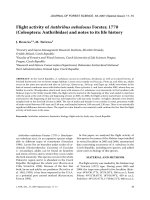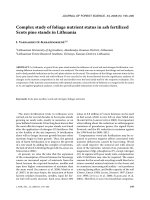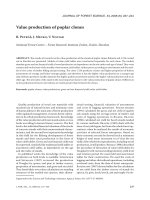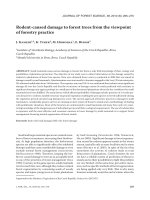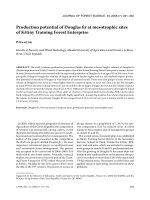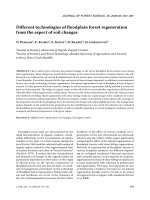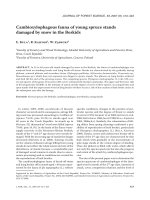Báo cáo lâm nghiệp: "Small mammals of a forest reserve and adjacent stands of the Kelečská pahorkatina Upland (Czech Republic) and their effect on forest dynamics" pps
Bạn đang xem bản rút gọn của tài liệu. Xem và tải ngay bản đầy đủ của tài liệu tại đây (342.63 KB, 9 trang )
50 J. FOR. SCI., 57, 2011 (2): 50–58
JOURNAL OF FOREST SCIENCE, 57, 2011 (2): 50–58
Small mammals of a forest reserve and adjacent stands
ofthe Kelečská pahorkatina Upland (Czech Republic)
andtheir eff ect on forest dynamics
J. S, J. U
Faculty of Forestry and Wood Technology, Mendel University in Brno, Brno, Czech Republic
ABSTRACT: The community of small terrestrial mammals (STM) was studied on seven experimental plots character-
izing forest stands in various stages of succession development and with different level of management from plantings
through production/commercial stands to a forest reserve. Increased attention was paid to dominant species and their
effects on the dynamics of the forest reserve. In total, eight species of STM were detected with the highest dominance
and abundance of Apodemus flavicollis and Myodes glareolus. The total relative abundance of STM was significantly
highest in plantings (P < 0.05). A. flavicollis was significantly most abundant in production beech stands (P < 0.05),
differences in the abundance among the other STM species being insignificant. The highest diversity was also deter-
mined in plantings (P < 0.05) as typical ecotone sites. Different natural conditions of open and high forest sites were
also reflected in different weight of specimens of dominant species of STM from these biotopes. In A. flavicollis, the
difference was highly significant (P < 0.01) and in M. glareolus significant (P < 0.05). Both species significantly affected
the forest reserve dynamics through the consumption of forest seeds, particularly of beechnuts (100% consumption of
the 2007 crop). However, according to the proportion of natural regeneration from previous years, the reserve proved
resistance to the impact of rodents caused by the consumption of seeds in a long-term horizon.
Keywords: Apodemus flavicollis; forest natural regeneration; Myodes glareolus; nature reserve; small terrestrial
mammals; tree seed crop
Supported by the Ministry of Education, Youth and Sports of the Czech Republic, Project No. MSM 6215648902, and
by the Ministry of Agriculture of the Czech republic, Project No. QH72075.
anks to their life strategy, small terrestrial mam-
mals are characterized by high reproduction capac-
ity and thus also by considerable fl uctuation of the
population dynamics, being important consumers
and secondary producers in ecosystems. e abil-
ity to reach considerable population densities un-
der optimum conditions signifi cantly aff ects the site
character occupied by the mammals, which can be
well documented also on forest ecosystems (P
et al. 1993; W 1996; J et al. 2004).
ere, the rate of their impact is dependent on the
level of ecological stability closely related with an-
thropogenic eff ects (H et al. 2007, 2008;
S 2008). As compared to cultivated
stands, natural and close-to-nature forests show a
number of self-regulation mechanisms allowing to
suppress impacts of the possible eff ect of rodents
in the period of their population peak (P et al.
1993; H et al. 2007, 2008). On the other
hand, production stands represent a more optimum
biotope for small mammals from the aspect of their
population density (Z et al. 2002; S,
H 2004, 2008), being therefore reservoirs
of stable and abundant populations also for the sur-
rounding area of natural character including nature
reserves. Small-area forest reserves surrounded by
commercial production stands and easily colonisa-
ble due to their insuffi cient area can be potentially
more stressed by the impact of small mammals than
extensive natural sites.
J. FOR. SCI., 57, 2011 (2): 50–58 51
In the present paper, problems of small terrestrial
mammals are analysed in relation to various types
of forest sites with an increased emphasis on domi-
nant species of rodents the role of which is crucial
in the dynamics of forest ecosystems (e.g. J
1982, 1985; P et al. 1993; J et
al. 2004). Data on other species of small terres-
trial mammals including insectivores were used to
evaluate the diversity of communities in particular
monitored biotopes and to assess their importance
for the species diversity of these animals.
Study Area
For the study of populations experimental plots
in the Valšovice Training Forest Range (Přerov Dis-
trict) were used, which is a special-purpose area
of the Secondary Forestry School in Hranice na
Moravě. e studied plots are situated in Natural
Forest Area No. 37 – the Kelečská pahorkatina Up-
land (in total 1,003.47 ha) on the boundary line of
the Oderské and Hostýnské vrchy Hills. ey cre-
ate a promontory of the Oderské vrchy Hills termi-
nated by the Maleník plateau. e highest peak in
the management-plan area (MPA) is Maleník with
its height of 479 m. Mean altitude a.s.l. ranges be-
tween 300 and 400 m. e lowest point of the MPA
is situated on the Bečva riverbank in the northern
part at an altitude of about 240 m. As for climate,
the locality belongs to a moderately warm region
with warm subregion B3, hilly country, slightly hu-
mid, with mild winters. Mean annual temperatures
are 7 to 8°C. Mean annual precipitation amounts to
600–700 mm, in recent years only to 450–500 mm.
Prevailing winds blow from NW–W–SW (accord-
ing to the Forest Management Plan 2001–2010). In
total, seven experimental plots were chosen with
a diff erent level of management, which included
diff erent forest sites from early succession stages
to natural forests free of management measures.
ree of the plots represented commercial stands
nearly of the character of beech monocultures
(P1–P3), two plots represented stands in the na-
ture reserve (P4, P5) and two plots were plantings
of various age (P6, P7):
P1 (49.525658 N, 17.6862752 E): stand part 4A14,
mean altitude 410 m, age 144 years, HS (manage-
ment group of stands) 4446, forest type 4B1. e
high-quality fruit-bearing beech (Fagus sylvatica)
stand of genetic classifi cation B, European larch
(Larix decidua) – 6%, small-leaved linden (Tilia cor-
data) ‒ 2%, sessile oak (Quercus petraea) ‒ 1%. Spo-
radically, natural regeneration of beech, sessile oak,
hornbeam (Carpinus betulus), smooth-leaved elm
(Ulmus carpinifolia), European ash (Fraxinus excel-
sior), sycamore maple (Acer pseudoplatanus), small-
leaved linden and larch. Convallaria majalis, Lathy-
rus vernus and Carex pilosa occur in undergrowth.
P2 (49.526033 N, 17.6875392 E): stand part 4A6a,
mean altitude 390 m, age 60 years, HS 4446, for-
est type 4B1. Mainly a pole-stage stand to a large-
diameter stand of European beech (Fagus sylvatica)
with an admixture of small-leaved linden (Tilia cor-
data). e herb layer consists of Convallaria maja-
lis, Lathyrus vernus and Carex pilosa.
P3 (49.523157 N, 17.6763829 E): stand part 5C12,
mean altitude 400 m, age 127 years, HS 16, forest
type 3J2. Protection forest – “lime-tree little rock”.
A mixed large-diameter stand (European beech
60%, small-leaved linden 32%, European larch 2%,
sessile oak 2%, European ash 2%, hornbeam 1% and
sycamore maple 1%) on a steep stony to boundary
slope, N–NW slope orientation with protruding
rocks. Convallaria majalis and Carex pilosa occur
in undergrowth.
P4 (49.5156567 N, 17.6964967 E): stand part
13C13, mean altitude 368 m, age 131 years, HS
4446, forest type 3B2. Eastern part of the nature
reserve called “Dvorčák”. A quality oak stand with
Fagus sylvatica and Quercus petraea grows on a
gentle SE–S slope, sporadically with gaps. Euro-
pean ash and small-leaved linden self-seeding or
even advance growth occur in undergrowth. Car-
pinus betulus and Acer pseudoplatanus with inter-
spersed Tilia cordata predominate in the tree layer.
Dominant species of the herb layer are as follows:
Lathyrus vernus, Convallaria majalis, Tithymalus
amygdaloides, Polygonatum multifl orum, Petasites
albus, Carex pilosa, Poa nemoralis etc.
P5 (49.5141806 N, 17.6887167 E): stand part
13C13, mean altitude 360 m, age 131 years, HS
4446, forest type 3B2. e “Dvorčák” Nature Re-
serve was established on 31 July 1962 by the decree
of the Ministry of Education and Culture on an area
of 11.71 ha as an evidence of the natural structure
of forests of the Moravian Gate. Fagus sylvatica
with interspersed Tilia cordata, Quercus petraea,
Carpinus betulus and Acer pseudoplatanus pre-
dominate in the tree layer. Dominant species of the
herb layer are: Lathyrus vernus, Convallaria maja-
lis, Tithymalus amygdaloides, Polygonatum multi-
fl orum, Petasites albus, Carex pilosa, Poa nemora-
lis etc.
P6 (49.30889 N, 17.41449 E): stand part 5G1b,
mean altitude 460 m, age 10 years, HS 446, forest
type 4B1. Artifi cial regeneration of beech Fagus
sylvatica (95%) with an admixture of ash Fraxinus
52 J. FOR. SCI., 57, 2011 (2): 50–58
excelsior (3%), silver fi r Abies alba (1%), larch Larix
decidua (1%), Alnus glutinosa, and Acer pseudo-
platanus, mainly with grasses (Calamagrostis arun-
dinacea) and Rubus fruticosus in its undergrowth.
P7 (49.31304 N, 17.41118 E): stand part 10C1,
mean altitude 380 m, age 9 years, HS 446, forest
type 3B2. e planting of Fagus sylvatica (74%)
with an admixture of Quercus petraea (10%), Fraxi-
nus excelsior (5%), Tilia cordata (5%), Carpinus
betulus (3%), Picea abies (1%), Acer pseudoplata-
nus (1%) and Ulmus carpinifolia (1%). e stand is
situated on a gentle SE slope dissected by water-
courses. Grasses (Calamagrostis arundinacea) and
Rubus fruticosus are dominant in the herb layer.
Sites in the nature reserve, where the majority of
studies regarding the impact of small rodents on
forest stands were carried out, represented basic
plots. Other plots served as comparative plots and
for obtaining a comprehensive view of the variety of
the small mammal synusia in the monitored region.
MATERIAL AND METHODS
e community of small mammals was studied
for a period of three years (2006–2008). In 2006,
two trappings were carried out in the spring (June)
and autumn season (October) and in 2007 and
2008, three trappings were carried out in the spring
(April), summer (July) and autumn (October) sea-
son. On each of the plots (P1–P5), 80–100 snap
traps were laid in a line at 3-m spacing (Table 1).
A kerosene lamp wick parched on oil and fl our or
smeared with peanut butter was used as bait. On
plots P6 and P7, 20–50 traps were laid. e low
number of traps in exclusion fences was used be-
cause the original intention was to trap small mam-
mals only in order to determine the species which
could be potential causal agents of damage to tree
plantings without another plan to study the popu-
lation dynamics or other properties of the commu-
nity. e smaller number of traps was also given by
the limited size of these two experimental plots.
e traps were exposed for the period of 4 days
(i.e. 3 nights) and checked in the morning every
day (P 1976). e species, body length and
weight of caught individuals were determined in
the laboratory. In species that can be confounded
(the genera Apodemus and Sorex) other length
measures were also determined. Particular animals
were dissected in order to determine sex and sexual
activities. Only those animals were considered to
be adult that showed characteristic features of ma-
turity, i.e. developed seminal vesicles and large tes-
ticles in males, and embryos in the uterus or scars
on the uterus after birth ‒ maculae cyaneae in fe-
males Z et al. 2002).
Basic ecological characteristics of the community
were evaluated, namely the dominance and relative
abundance of selected species (according to L
et al. 1985), diversity (S, W 1963)
and equitability (S 1969). In total, 654
small mammals were caught (Table 1).
Statistical evaluation was carried out by means
of the Statistica.cz version 8 programme. e t-test
was used for independent samples (comparisons of
the weight of animals, diversity of two sites and rel-
ative abundance of two types of sites and two domi-
Table 1. Values of dominance (D), relative abundance (rA), diversity (H') and equitability (E) at communities of small
terrestrial mammals detected at studied plots (Σ(n) – total number of individuals, NTP – number of traps and nights,
P1 to P7 – experimental plots, description see Chapter of the studied area)
Species
P1 P2 P3 P4 P5 P6 P7
D (%) rA D (%) rA D (%) rA D (%) rA D (%) rA D (%) rA D (%) rA
Apodemus fl avicollis 76.3 3.63 64.1 2.08 78.2 3.87 56.9 2.58 62.1 1.62 17.8 1.72 10.5 1.08
Apodemus sylvaticus 7.9 0.38 10.3 0.33 6.4 0.32 6.4 0.29 12.1 0.32 6.7 0.65 2.1 0.22
Apodemus agrarius 0 0 0 0 0 0 6.4 0.29 3.5 0.09 32.2 3.12 28.4 2.9
Myodes glareolus 15.8 0.75 24.4 0.8 15.5 0,77 28.4 1.29 22.4 0.59 37.8 3.66 39.0 3.98
Microtus agrestis 0 0 0 0 0 0 0.9 0.04 0 0 1.1 0.11 11.6 1.18
Sorex araneus 0 0 1.3 0.04 0 0 0.9 0.04 0 0 2.2 0.22 5.3 0.54
Sorex minutus 0 0 0 0 0 0 0 0 0 0 1.1 0.11 3.2 0.32
Talpa europaea 0 0 0 0 0 0 0 0 0 0 1.1 0.11 0 0
Σn 114 78 110 109 58 90 95
NTP 2,400 2,400 2,220 2,400 2,220 930 930
H' 0,678 0.912 0.7 1.117 1.003 1.456 1.557
E 0.617 0.658 0.637 0.623 0.724 0.7 0.8
J. FOR. SCI., 57, 2011 (2): 50–58 53
nant species of rodents), ANOVA was used to com-
pare the diversity of all trial plots, and Tukey’s HSD
test and Duncan’s post-hoc test were employed to
compare the diversity of three types of sites.
Eff ects of small mammals on forest regeneration
were assessed according to the consumption of
tree seeds and the amount of emerged seedlings.
e actual food off er of seeds was determined in
the nature reserve (P4, P5) in the autumn season
(2007), namely from ten randomly selected small
plots 50 × 50 cm in size converted to ha. e total
number of rodents per ha to estimate the seed con-
sumption was calculated according to Z et
al. (2000). e total estimate of seed consumption
(beechnuts) per ha by the rodent species (Apode-
mus fl avicollis, Myodes glareolus) was calculated
according to H et al. (2008). e level
of natural regeneration in the reserve was evalu-
ated for the purpose of its eff ectiveness, namely
by a single application (in 2008) through checking
the number of the youngest tree individuals (up to
3 years of age) on ten randomly selected 10 m
2
plots
and then also converted to hectares (Table 2).
RESULTS
In total, eight species of small mammals were
found out in the studied area, namely 5 species of
rodents and 3 species of insectivores (Eulipotyphla,
syn. Insectivora). Apodemus fl avicollis with the total
dominance D = 53.1% together with Myodes glareo-
lus with D = 25.8% was the most abundant species
in the area. e rodents represented the group of
eudominant species (D > 10%). Moreover, the fol-
lowing species occurred on these plots: dominant
(D = 5–10%) A. agrarius with D = 9.9%, A. sylvati-
cus with D = 7.0%, recedent (D = 1–2%) Microtus
agrestis with D = 1.99 % and Sorex araneus with
D = 1.38% and subrecedent (D < 1%) S. minutus with
D = 0.61% and Talpa europaea with D =0.15%. e
proportions of all determined species on particular
plots and their abundance are given in Table 1.
e total abundance (rA) of small mammals sig-
nifi cantly fl uctuated depending on the site charac-
ter (Fig. 1) while populations of open sites reached
markedly higher abundance (t= –2.698; P = 0.017,
t-test). Apodemus fl avicollis and Myodes glareolus
were the most important species of small mam-
mals thanks to the values of dominance and rela-
tive abundance. A suffi cient amount of data made
it possible to monitor also the fl uctuation of their
population dynamics with a possibility to pre-
dict eff ects on the regeneration of forest stands
(Figs. 2–5). However, there were considerable dis-
proportions in dominance and abundance revealed
by the evaluation of particular types of sites which
were related with the biotope preferences of both
species (Table 1; Figs. 2–5).
Apodemus fl avicollis was the most abundant at
localities P1–P5 with high-quality stands of seed-
bearing trees (particularly beechnuts). It mark-
edly predominated in commercial stands repre-
senting nearly pure beech stands (P1–P3; D >75%;
rA > 3.6). Its abundance was signifi cantly higher
than the abundance of Myodes glareolus (t = 2.358;
P = 0.033, t-test). Natural sites of forest reserves
(P4, P5) were also a suitable biotope. However, the
dominance and abundance of the species was natu-
rally lower there (D = 57–62%; rA = 1.6–2.6) with
respect to the higher species and structural diversi-
ty of trees and microbiotopes limiting the ecologi-
cal niche of Apodemus fl avicollis and allowing the
occurrence of a number of other species of small
mammals (Table 1). Open sites of plantings were
substantially less suitable for Apodemus fl avicol-
lis (P6, P7; D = 10–18%; rA = 1–1.7). However, the
diff erences in abundance from mature stands were
not signifi cant (P > 0.05, t-test).
On the other hand, Myodes glareolus was the
most abundant species at open sites of plantings
(D = 38–39%) reaching the highest abundance out
of all local small mammals (rA = ca 4.0). e dif-
ferences in abundance from mature stands were
not however signifi cant (P > 0.05; t-test). us,
both species showed quite diff erent fl uctuations of
population dynamics at sites of full-grown stands
(P1–P5) and in the early succession stages of plant-
ings (P6, P7) (Figs. 2–5) although signifi cant diff er-
ences were found only between populations of both
species in mature forest stands.
As for the other species of marked dominance
which can be important consumers in local for-
est ecosystems thanks to their abundance, we can
Table 2. e number of seedlings of various tree species (pcs·ha
–1
) and their proportion (%) in natural regeneration
in the Dvorčák nature reserve
Fagus sylvatica Quercus petraea Fraxinus excelsior Tilia cordata Carpinus betulus Acer pseudoplatanus
pcs·ha
–1
10,600 7,600 3,400 1,600 7,400 100
(%) 34.53 24.76 11.07 5.21 24.1 0.33
54 J. FOR. SCI., 57, 2011 (2): 50–58
mention Apodemus agrarius with D = 3.5–6.4% in
mature stands (P4, P5) and with D = 28.4–32.2% in
plantings (P6, P7) and Microtus agrestis on a clear-
ing P7 (D = 11.6%) (Table 1).
e diversity of monitored sites showed a sig-
nifi cant eff ect on the character of diversity of small
mammals (Table 1). e highest index of diversity
was shown by plantings as early succession stages
of forest stands (P6, H' = 1.46; P7, H' = 1.56). For-
est reserves (P4, P5) showed somewhat lower di-
versity (H' = 1.0–1.12) due to the limited amount of
open sites and thus the absence of specialized spe-
cies. Commercial beech stands (P1–P3) with the
limited diversity of habitats and low diff erentiation
of food sources (H' = 0.68–0.9) showed the lowest
diversity. However, in spite of the given diff erences,
no statistically signifi cant diff erences (ANOVA)
were detected among the particular experimen-
tal plots. At a simpler division only into open sites
(plantings) and closed mature stands diversity was
signifi cantly diff erent (t = –2.586; P = 0.012, t-test)
similarly like among the three types of biotopes ac-
cording to the method of management representing
the given plots, i.e. seed-bearing cultivated beech
stands (P1–P3), forest reserve (P4, P5) and plantings
(F = 3.342; P = 0.043, ANOVA). At a subsequent
multiple comparison (ANOVA, Tukey’s HSD test),
a signifi cant diff erence in diversity was determined
between seed-bearing beech monocultures and
plantings (P = 0.043). No diff erence between these
two types of sites and the forest reserve was found
6
8
10
12
14
16
18
0
2
4
6
8
10
12
14
16
18
VI 06
X 06
IV 07
VII 07
X 07
IV 08
VII 08
X 08
DL
VS
3
4
5
6
7
8
9
10
DL
VS
0
1
2
3
4
5
6
7
8
9
10
VI 06 X 06 IV 07 VII 07 X 07 IV 08 VII 08 X 08
DL
VS
3
4
5
6
7
8
9
10
DL
VS
0
1
2
3
4
5
6
7
8
9
10
VI 06 X 06 IV 07 VII 07 X 07 IV 08 VII 08 X 08
DL
VS
3
4
5
6
7
8
9
10
AF
MG
0
1
2
3
4
5
6
7
8
9
10
VI 06 X 06 IV 07 VII 07 X 07 IV 08 VII 08 X 08
AF
MG
3
4
5
6
7
8
9
10
AF
MG
0
1
2
3
4
5
6
7
8
9
10
VI 06 X 06 IV 07 VII 07 X 07 IV 08 VII 08 X 08
AF
MG
Fig.1. Fluctuations of the abundance of small mammals in
various succession stages of forest ecosystems (DL – mature
stands, VS – plantings) in the monitored area
Fig. 2. Fluctuations of the abundance of Apodemus fl avicollis
in various succession stages of forest ecosystems (DL – ma-
ture stands, VS – plantings) in the monitored area
Fig. 3. Fluctuations of the abundance of Myodes glareolus in
various succession stages of forest ecosystems (DL – mature
stands, VS – plantings) in the monitored area
Fig. 4. Diff erences in the relative abundance fl uctuation of
Apodemus fl avicollis (AF) and Myodes glareolus (MG) in
mature forest stands
Fig. 5. Fluctuations of population dynamics of Apodemus
fl avicollis (AF) and Myodes glareolus (MG) in plantings in
the monitored area
J. FOR. SCI., 57, 2011 (2): 50–58 55
out. However, using Duncan’s post-hoc test, a statis-
tically signifi cant diff erence was calculated even be-
tween the planting and the forest reserve (P = 0.042)
as well as between the planting and the seed-bearing
cultivated beech stand (P = 0.026). Communities of
small mammals of mature forest stands were also
less equalized (E) than in plantings (Table 1).
Forest plantings as succession-initial stages of the
forest development show quite diff erent life condi-
tions from those of high forests, which became evi-
dent also on the fi tness of local populations of small
mammals. us, some diff erences were determined
between the weights of populations of dominant
species (Apodemus fl avicollis, Myodes glareolus)
from both types of sites. e values were signifi -
cant both in adult Myodes glareolus (t = –2.143,
P = 0.037, t-test) when the mean weight of indi-
viduals in forests was 20.38 ± 2.79 g and in plant-
ings 22.22± 3.47 g and in all individuals including
subadult ones (t = –2.246; P = 0.026, t-test) when
the mean weight was 17.76 ± 3.41 g in forests and
19.01 ± 3.74 g in plantings.
In A. fl avicollis, the weight diff erence in all indi-
viduals without exception of sex activities was even
highly signifi cant (t = 3.808; P = 0.00017, t-test). In-
dividuals showed the mean weight of 30.26 ± 9.01g
in the forest and only 23.4 ± 5.95 g in plantings.
Similarly, there was a high signifi cance also in the
case of separation of adult, i.e. sexually active, in-
dividuals, when their weight was 35.65 ± 6.84 g in
the forest and 27.2 ± 4.31 g (t = 3.850; P = 0.00017,
t-test) in plantings.
e population of granivorous species of small
mammals was also aff ected by food off er in the
form of tree seeds. eir actual amount aimed at
beech was studied in the nature reserve in autumn
2007. e total number of fallen seeds reached (af-
ter conversion) 824,000 per ha. e highest pro-
duction was found in beech, viz 596,000 seeds per
ha (D = 72.3%). Hornbeam also provided a signifi -
cant source of food, namely 184,000 seeds per ha
(D = 22.3%). e other two detected tree species
produced seeds rather sporadically in the given
year. Small-leaved linden provided about 40,000
seeds per ha (D = 4.85%) and sessile oak only 4,000
seeds per ha (D = 0.5%).
Depending on the food off er mentioned above
the total numbers of individuals of A. fl avicollis
and Myodes glareolus were determined in the forest
reserve in autumn 2007, namely about 111 yellow-
necked mice·ha
–1
and about 92 bank voles·ha
–1
.
With respect to the low crop of seeds of other
woody species attention was paid only to the im-
pact of rodents on the food off er of beechnuts. e
consumption of beechnuts by A. fl avicollis was esti-
mated to be 2,109 beechnuts·day
–1
·ha
–1
, i.e. within
the next 10 months when seeds were utilizable by
rodents the potential consumption amounted to
about 632,700 beechnuts·ha
–1
. As for Myodes glareo-
lus, its consumption was 1,104 beechnuts·day
–1
·ha
–1
,
which amounted to about 331,200 beechnuts/ha/ten
months. It follows that a loss of seeds caused by ro-
dents was virtually 100% making the stand regenera-
tion impossible in the next year. Checking the natu-
ral regeneration also proved it.
To assess the function of self-regulation mecha-
nisms in the reserve in spite of the high consumption
of seeds by small rodents the inspection of natural
regeneration was carried out. In total, the inspec-
tion recorded 30,700 seedlings of various species per
ha in 2008. e predominance of beech (34.5%; see
Table 2) was marked. However, these were mostly
older individuals (aged minimally 2–3 years) while
new regeneration from beechnuts (crop of 2007)
was virtually absent.
DISCUSSION
Forest stands in the monitored area represent
suitable biotopes for eudominant species of small
mammals such as Apodemus fl avicollis and Myodes
glareolus, signifi cantly aff ecting the dynamics of
forest ecosystem by the consumption of tree seeds
(J 1985; P et al. 1993; W 1996; J-
et al. 2004; H et al. 2008;
S, H 2008). Particularly sites
with the predominance of fructiferous beech (Fa-
gus sylvatica) trees, the seeds of which represent a
substantial part of food of both species (H
1971; O, H 1974; H, O-
1980; P et al. 1974; A, B 1998),
are an important reservoir of populations for the
whole monitored area particularly in years of seed
crop (there in 2007). e dominance of Myodes
glareolus was, however, substantially lower in these
biotopes than that of Apodemus fl avicollis by rea-
son of its high abundance, aggressiveness and com-
petitiveness (M, G 1985; Z-
2002). It became evident particularly on plots
in commercial stands (P1, P3; D < 16%, rA < 0.8;
Table 1).
On the contrary, Myodes glareolus was the most
abundant in plantings representing an optimum
biotope for this species due to the dense herb layer
providing necessary protection cover and enough
food in the form of green plant matter (e.g. Ru-
bus spp.), which is, in addition to seeds, the most
56 J. FOR. SCI., 57, 2011 (2): 50–58
important component of food (H 1971;
O, H 1974; A, B 1998; H-
et al. 2007). On the other hand, plantings
were unsuitable for Apodemus fl avicollis (lack of
food off er in the form of tree seeds), which rath-
er uses them as migration routes (N,
K 1978; Z et al. 2002).
e occurrence of A. agrarius can be consid-
ered interesting in these stands. It is commonly
reported as a species of open sites, particularly in
agricultural landscape, with close relations to moist
biotopes (N, K 1978; Z et al.
2002). e high abundance and dominance in for-
est plantings (rA about 3) can evidence rather hu-
mid microclimate of the site. Its food preferences
include a high proportion of invertebrates and
small seeds (weeds, grasses), therefore its eff ect
on forest regeneration is negligible having quite a
positive role by the consumption of animals (Z-
et al. 2002). e marked dominance of bank
vole in plantings (D = 11.6%) was also important.
is species is potentially an important pest of lo-
cal beech stands due to bark browsing (G 1992;
H et al. 2007).
Soricidae showed rather low dominance as well as
relative abundance in the area (Table 1), which can
be related with the total fall of the group in Mora-
via in the last decades (S, H
2004). Generally, small mammals showed slightly
higher abundance at open sites (Fig. 1) which rep-
resent an important reservoir of rodents there (par-
ticularly of Arvicolidae). ese rodents can aff ect
forest regeneration by bark browsing (G 1992;
H et al. 2007; S 2008).
In addition to the high abundance of small mam-
mals higher species diversity was also observed at
open sites of plantings. It corresponds to the level
of richly structured biotopes (P 1986, 1989;
S et al. 1996; B et. al. 2001; S,
H 2004, 2007) being related with the site
character, which represents (thanks to its limited
size and vicinity of forest stands) a characteristic
ecotone zone with a marked ecotone eff ect, i.e. the
occurrence of both forest and nonforest species
of small mammals (P 1986; S et al.
1996; S, H 2004, 2007).
It means that the structure of the community of
small terrestrial mammals and population dynam-
ics as well as the fi tness of particular species are
dependent on the site character. Similarly, popu-
lations of small mammals aff ect the site, in forest
ecosystems particularly by the intensity of their
impact on forest regeneration. In this sense, the
most important are dominant species of rodents
aff ecting forest regeneration mainly by the con-
sumption of tree seeds and seedlings (P et al.
1993; J et al. 2004; H et
al. 2008; S, H 2008) or bark
browsing in the winter season under the shortage
of food off er (G 1992; H et al. 2007).
e resistance of forest biotope to damage caused
to (natural and artifi cial) regeneration depends on
its ecological stability and structure (H
et al. 2007; S 2008).
Eff ects of small mammals on the forest dynam-
ics resulting from the consumption of tree seeds as
well as their dependence on food off er were quite
frequently studied under conditions of this country
(e.g. P et al. 1974; H et al. 2008;
S, H 2006, 2008) and particu-
larly elsewhere in Europe (e.g. J 1982, 1985;
F et al. 1985; P et al. 1993; W
1996; J et al. 2004 etc.). In the area
under study, the seed crop caused an increase in
the small mammal population (particularly of A.
fl avicollis) during two successive years (2007, 2008,
Figs. 1, 2, 4) with the population peak in 2007. Be-
cause small mammals respond to the increased
food off er by an increase of their populations with
some (sometimes even one-year) delay (J
1982; F et al. 1985), their population
peak in 2007 was aff ected by the crop of oak (Quer-
cus spp.) trees in 2006 and then the higher abun-
dance in 2008 (as against 2006) by the beech crop
in 2007. Although the inspection of oak seed crop
was not carried out in the studied region in 2006, it
is possible to suppose it both according to the high
populations of rodents and according to the crop of
acorns at other localities in Moravia (S,
H 2008). In 2007, the crop of beechnuts
occurred at the locality synchronously with the
crop of beechnuts in piedmont and mountain areas
(H et al. 2008).
e crop of beechnuts was completely consumed
by rodents, which was caused partly by its rather
small amount (e.g. in the Beskids in the same year,
the crop was 1,600,000 beechnuts·ha
–1
– H-
et al. 2008) and partly by the high abundance
of rodents (e.g. in the Beskids Mts. in the same time,
only twelve A. fl avicollis per ha were found and one
Myodes glareolus per ha ‒ H et al. 2008),
which was a result of the population density increase
as a response to high food off er from the oak crop
in 2006. e total consumption of seed reserves was
also aff ected by the unsuitable timing of beechnut
crop to the year of the highest abundance of small
mammals on plots P1–P5 for the monitored three-
year period (2007; Figs. 2 and 4).
J. FOR. SCI., 57, 2011 (2): 50–58 57
At the surplus of seeds, rodents feed nearly ex-
clusively on them, which may result in 100% losses
(J et al. 2004) already mentioned
above. For example, at sites with fructiferous beech
trees in the Beskids, the consumption of seeds and
beechnuts by Myodes glareolus accounted for even
80% of the stomach content (B et al. 2001).
However, at really high amounts of seeds, small
mammals are not able to consume the crop totally
(J 1985; W 1996; J et al.
2004). It became evident e.g. in the Beskids Mts.,
where the two species consumed about 42.75% of
the beechnut crop in the given year (H
et al. 2008).
In addition to the actual consumption of beech-
nuts which is mostly considered to be negative, small
mammals also play a positive role in the distribution
of seeds at a site. For example, A. fl avicollis prepares
seed reserves for the winter season (as many as 4kg)
which are not, however, fully used and thus the spe-
cies contributes to the distribution of beechnuts
(N, K 1978; Z et al. 2002.
In spite of the considerable stress on the seed
crop through the small rodent predation natural
regeneration was found out in the reserve, particu-
larly from the previous year dispersion when lower
numbers of rodents occurred (Figs. 2–5) and po-
tentially also a higher crop. e occurrence of seed-
lings from previous years evidences the long-term
suffi cient regeneration capacity of this forest stand
and a certain level of resistance to the impact of
small rodents in spite of unfavourable years of the
total disposal of seed crop.
In addition to the eff ect of small mammals on
stands through the consumption of seeds their im-
pact by bark browsing was also described in the
monitored nature reserve (S 2008). Anal-
yses confi rmed the substantially higher resistance
of natural regeneration to browsing in the reserve
than in plantings (G 1992; Z et al. 2002;
H et al. 2007).
us, it is possible to state that the impacts of
bark browsing exert substantially smaller eff ects on
forest regeneration in forest reserves than the con-
sumption of tree seeds (G 1992; H et
al. 2008; S 2008). Unsuitable site condi-
tions for rodents particularly of the genus Micro-
tus, such as sparse herb layer, easier accessibility
to predators, intense competition of A. fl avicol-
lis, protection of seedlings by their accumulation
into groups of high densities when only individuals
along the margins are available etc. are the reasons
for the low rate of damage and higher resistance of
young trees.
CONCLUSION
anks to their diff erent character, the studied
forest sites aff ected the population dynamics, di-
versity and fi tness of selected species of small ter-
restrial mammals to a diff erent extent evidencing
the importance of biotope diff erentiation for the
species diversity of these animals. e nature re-
serve, which was in the foreground of our interest,
proved resistance to the impact of rodents caused
by the consumption of seeds in the long-term ho-
rizon. With respect to specifi c conditions which
resulted in the presence of a large population of
rodents at the locality in the period of beechnut
crop, intensive consumption of this food off er oc-
curred as well as its subsequent disposal and thus
new natural regeneration in the next year was pre-
vented. It was a marked intervention into the for-
est stand dynamics. Natural regeneration in the
reserve showed substantially higher resistance to
bark browsing than plantings, thus representing a
smaller intervention into the stand dynamics than
the seed consumption. Plantings and cultivated
beech stands are reservoirs of populations of domi-
nant species of small mammals which can inten-
sively colonize surrounding natural forests and af-
fect the dynamics of these ecosystems depending
on their population dynamics.
Re fe re nc es
A K.F., B W.F. (1998): Seasonal variations of diet
composition in farmland fi eld mice Apodemus spp. and
bank voles Clethrionomys glareolus. Acta eriologica,
43: 379–389.
B J., H M., Z J. 2001: Small mam-
mal communities of top parts of Beskids Mts. Zpravodaj
Beskydy, 14: 201–208. (in Czech).
F S.R., G J., G J.M.W. (eds) (1985):
e Ecology of Woodland Rodents Bank Voles and Wood
Mice. Zoological Society of London Symposia 55, Oxford
Science Publications: 415
G R.M.A. 1992: A review of damage by mammals in
north temperate forests. 2. Small mammals. Forestry, 65:
281–308.
H M., S J., P L., H
M., K J. (2007): Small forest rodents – an impor-
tant factor in the regeneration of forest stands. Beskydy,
20: 217–220.
H M., S J., P L., H M.
(2008): e role of granivorous forest rodents in beech re-
generation in the Beskidy Mts. (Czech Republic). Beskydy,
1:131–134.
58 J. FOR. SCI., 57, 2011 (2): 50–58
H V. (1971): e food of Clethrionomys glareolus at
diff erent population densities. Acta Scientarium Natura-
lium Brno, 5 (11): 1–43.
H V., O R. 1980): Variation in the trophic
niche of Apodemus fl avicollis in two diff erent habitats.
Folia Zoologica, 29: 33–41.
J B., P Z., J W. (2004): Seed
crops and forest rodents. In: J B., W
J. M. (eds): Esseys on Mammals of Bialowieza Forest. Bi-
alowieza, Mammal Research Institute: 129–138.
J T.S. (1982): Seed production and outbreaks of non-
cyclic rodent populations in deciduous forests. Oecologia,
54: 184–192.
J T.S. (1985): Seed predator interactions of European
beech Fagus sylvatica and forest rodents Clethrionomys
glareolus and Apodemus fl avicollis. Oikos, 44: 149–156.
L B., G J., L J., P J. (1985): Animal
Ecology. Praha, SPN: 320 (in Czech).
M W.I., G J. (1985): e behaviour of
Apodemus. In: F S.R., G J., G J.M.W.
(eds): e Ecology of Woodland Rodents Bank Voles and
Wood Mice. Zoological Society of London Symposia 55,
Oxford Science Publications: 89–115.
N J., K F. (1978): Handbuch der Saugetiere
Europas. Vol. 1. Rodentia. Akademische Verlagsgesellschaft
(Wiesbaden): 476.
O R., H V. (1974): Trophic niches of Apodemus
fl avicollis and Clethrionomys glareolus in a lowland forest.
Acta Scientarium Naturalium Brno, 8: 1–37.
P J. (1976): e estimation of population density in
small mammals. In: P E.D.K. (ed.): Secondary
Productivity of Terrestrial Ecosystems. Warszawa, Panst-
wowe Wydawnictwo Naukowe: 167–273.
P J. (1986): Small mammals in windbreaks and adja-
cent fi elds. Acta Scientarium Naturalium Brno, 20: 1–38.
P J. (1989): Small mammals in fragments of Robinia
pseudoacacia stands. Folia Zoologica, 38: 199–212.
P J., Z J., H V. (1974): Standing crop es-
timates of small mammals in Moravian forests. Zoologické
listy, 23: 197–216.
P Z., J W., J B., P M.
(1993): Rodent population dynamics in a primeval decidu-
ous forest (Białewieża National Park) in relation to weather,
seed crop, and predation. Acta eriologica, 38: 199–232.
S C.E., W W. (1963): The Mathematical
eory of Communication. Urbana, University Illinois
Press: 144
S A.L. 1969: Equitability indices: Dependence on
the species count. Ecology, 50: 466–467.
S M., M L., F J. (1996): Small mam-
mals in fragments of Robinia pseudoacacia stands in the
east Slovakian lowlands. Folia Zoologica, 45: 145–152.
S J. (2008): A contribution towards the knowledge
of the eff ect of small mammals on the regeneration of
forest trees in selected stands of the Keleč Upland (Czech
Republic). Acta Universitatis Agriculturae et Silviculturae
Mendelianae Brunensis, LVI: 267–270.
S J., H M. (2004): Small terrestrial mam-
mals in two types of forest complexes in intensively man-
aged landscape of the South Moravia ( e Czech Republic).
Ekológia, 23: 377–384.
S J., H M. (2007): A pheasantry as the
site of small terrestrial mammals (Rodentia, Insectivora)
in southern Moravia (Czech Republic). Journal of Forest
Science, 53: 185–191.
S J., H M. 2008): Eff ect of seed crop
of trees on the abundance and body parameters of
granivorous mammals in isolated forest stands of southern
Moravia (Czech Republic). Polish Journal of Ecology, 56:
155–160.
W J.O. (1996): Population fl uctuations of mast-eating
rodents are correlated with the production of acorns.
Journal of Mammalogy, 77: 850–856.
Z M., O D., P J., Z J., P
J. (jr.), B M., H M. (2000): e Common
vole Microtus arvalis (Pallas, 1779) in the Czech Republic.
Brno, CERM: 128 (in Czech).
Z J. (2002): A yellow-necked mouse attacked a dead bank
vole. Acta eriologica, 47: 221–222.
Z J., Z M., P J., O D., H-
M., H Z. (2002): e rodents in practice
of the agriculture and forestry. Praha, Agrospoj: 284 (in
Czech).
Received for publication January 7, 2010
Accepted after corrections September 29, 2010
Corresponding author:
Doc. Ing. J S, Ph.D., Mendel University in Brno, Faculty of Forestry and Wood Technology,
Department of Forest Ecology, Zemědělská 3, 613 00 Brno, Czech Republic
e-mail:
